1. Introduction to Area Measurement
Need to convert square meters to square feet, acres to hectares, or other area units? Our Area Converter Tool lets you instantly convert between all standard units of land and surface area with high accuracy.
Ideal for real estate, construction, farming, or academic use — this tool makes area conversion simple, fast, and error-free.
Table of Contents
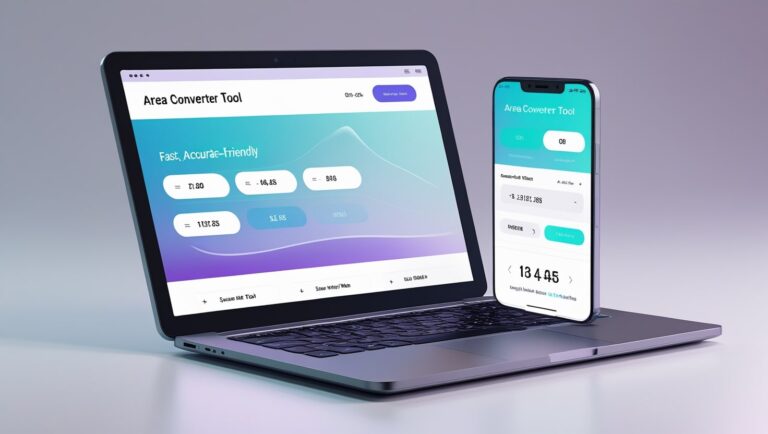
What is Area?
Area is a fundamental concept in geometry and everyday life. It refers to the amount of space within the boundaries of a two-dimensional shape. Whether you’re measuring the surface of a plot of land or the space inside a room, understanding how to calculate and convert area is vital.
In mathematical terms, area is measured in square units — such as square meters (m²), square feet (ft²), or acres. Every object or region with length and width has an area, and it’s often one of the first measurements considered in real estate, construction, landscaping, and even art.
Importance of Area in Daily Life
From buying a purse that fits in a specific space to calculating how many tiles are needed to cover a kitchen floor, area impacts daily decision-making. Understanding and converting area ensures accuracy in costs, materials, and planning.
For instance, someone purchasing land abroad might encounter unfamiliar units. An efficient area converter tool eliminates confusion, bridges gaps in regional measurement systems, and supports better decisions.
Units of Area Around the World
Globally, different countries and industries use different area units:
- Square Meters and Hectares: Common in Europe, Asia, and Australia.
- Square Feet and Acres: Frequently used in the United States.
- Bigha and Katha: Traditional Indian units.
- Tsubo: Used in Japan for real estate.
Because of this diversity, a versatile converter like the MiniToolLab Area Converter Tool is essential.
2. Common Use Cases of Area Converter:
Real Estate and Property Measurements
Real estate listings often show area in local units. Converting them for international buyers is key. If you’re a realtor working with global clients, an area converter tool ensures transparency and builds trust.
Construction and Architecture
Accurate area converter help architects plan space, material requirements, and costs. Tools remove manual errors and streamline communication across stakeholders.
Agriculture and Land Surveys
Farmers and surveyors use units like acres, hectares, or local terms like gunta or bigha. A tool standardizes data and makes record-keeping more efficient.
Education and Academic Applications
Teachers and students use area converter in geometry, geography, and environmental science. An online tool simplifies learning and demonstrates real-world utility.
Interior Design and Space Planning
Designers use area to calculate flooring, furniture fit, and space optimization. A quick tool helps them convert between client and supplier units in seconds.
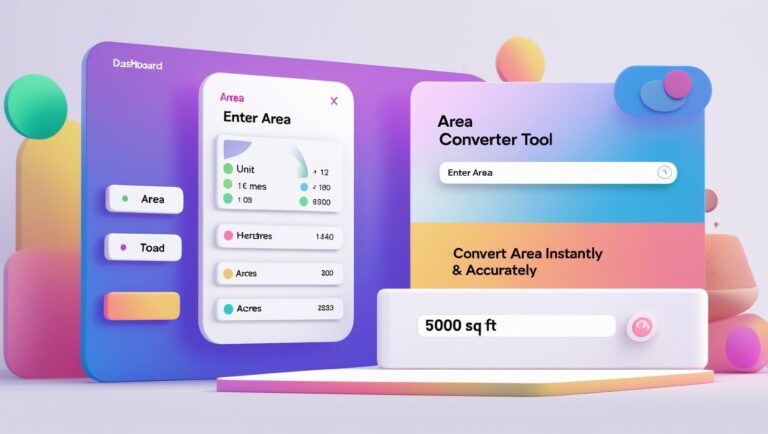
3. Understanding Area Units
Square Meter (m²)
The SI unit of area, widely used in science and engineering.
Square Kilometer (km²)
Used to describe geographical areas like cities or forests.
Square Feet (ft²)
Popular in real estate, especially in the U.S. and Canada.
Square Yards (yd²)
Common in construction and textiles.
Acres and Hectares
Used for larger plots of land; 1 hectare = 2.471 acres.
Unusual Units: Bigha, Are, Gunta
Found in specific countries or regions. Tools must include them for broad utility.
4. Why You Need an Area Converter Tool
Manual Conversion Challenges
Manual calculations require memorizing formulas and conversion rates, which can lead to human error.
Mistakes in Paper-Based Calculations
A misplaced decimal can cost thousands in land disputes or incorrect purchases.
Time-Saving Advantages
An automated converter provides results instantly — no need for spreadsheets or calculators.
Cross-Border Measurement Needs
In a globalized world, you may receive measurements in a foreign unit. An online converter bridges that gap easily.
For More Resources:
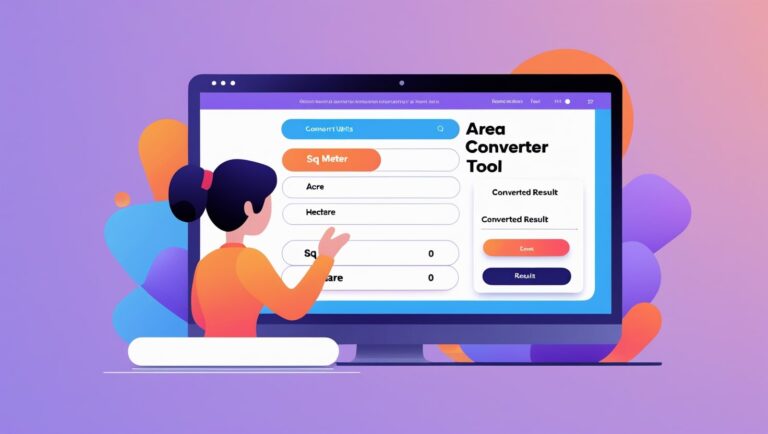
5. Features of a Good Area Converter Tool
Accurate Calculations
Precision is key. The MiniToolLab Area Converter Tool ensures mathematical accuracy across units.
Real-time Results
Instant conversion as soon as input changes — no delays.
Multi-Unit Support
Supports both standard and regional units like bigha, gunta, or square rods.
Easy User Interface
Clean, minimal design lets users focus on results without distractions.
Mobile and Desktop Friendly
Responsive design works across devices — ideal for fieldwork or classroom use.
Offline Accessibility
Advanced tools offer downloadable versions for offline environments.
6. Step-by-Step Guide: How to Use Area Converter Tool
Introduction to MiniToolLab Area Converter Tool
The MiniToolLab Area Converter Tool is an intuitive, reliable, and efficient online tool built to convert between dozens of area units with ease. Whether you’re dealing with hectares or square inches, this tool makes it simple.
Here’s a detailed walk-through to help you use the tool effectively.
Step 1: Enter the Numerical Value
Start by entering the numerical value of the area you want to convert. For example, if you’re converting 150 square meters into square feet, input “150” into the value field. The interface is clean, so the input box is prominently visible and easy to access.
Step 2: Select the Input Unit
Use the dropdown list to select the unit that corresponds to the number you’ve entered. Options include:
- Square meters (m²)
- Square kilometers (km²)
- Square feet (ft²)
- Square yards (yd²)
- Acres, hectares, and more
You can also find traditional and localized units like bigha, marla, or gunta for region-specific conversions.
Step 3: Select the Target Unit
Next, choose the unit you want to convert into. The target unit options are just as extensive and support conversion in both metric and imperial systems.
The ability to convert from a standard unit like hectares to a niche one like katha makes this tool valuable for professionals across industries.
Step 4: Review the Converted Value
The tool instantly displays the result after both units are selected. The answer is shown in a large, legible font, ensuring clarity even on mobile screens.
Example:
- Input: 150 square meters
- Output: 1614.59 square feet
The precision is tailored for practical use and is often displayed up to two or more decimal places, based on your settings.
Step 5: Copy or Export Results
Need to use the result in a document or spreadsheet? You can simply copy the value or use any available export options such as CSV or PDF (if supported). This saves time and ensures accuracy when reporting or sharing data.
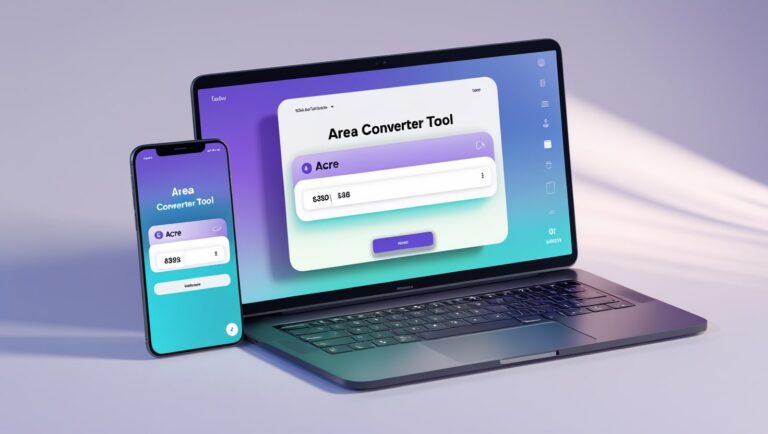
7. Advanced Tips for Using the Tool Efficiently
Converting Multiple Areas at Once
Some professionals work with bulk data — for instance, real estate agents handling multiple properties. You can open multiple tabs or use batch conversion features if provided, to streamline the process.
Bookmarking Frequent Conversions
If you frequently convert the same unit pairs, bookmark the tool’s page with pre-filled parameters. This allows for even faster access in the future.
Example: Bookmark a link with pre-set from “acres” to “square meters.”
Using the Tool on Mobile Devices
The MiniToolLab Area Converter Tool is mobile-optimized. You can convert area units on the go, whether you’re on a construction site, farm, or classroom.
Embedding the Tool on Your Website
If you own a blog, real estate site, or educational platform, embedding this area converter can increase user engagement. Visitors stay longer and find added utility directly on your page.
8. Accuracy and Validation
How Reliable Are Online Converters?
Modern area converters like the one by MiniToolLab are built using precise mathematical formulas and APIs that ensure consistent and accurate results.
Manual Checks to Validate Tool Results
For peace of mind, you can double-check by using:
- Online math calculators
- Official measurement standards from government agencies
- Spreadsheet formulas (e.g., Excel, Google Sheets)
Rounding Off and Precision Considerations
In real-life use, it’s sometimes practical to round off to the nearest whole number — especially in fields like real estate or landscaping. Tools often allow users to choose the level of decimal precision.
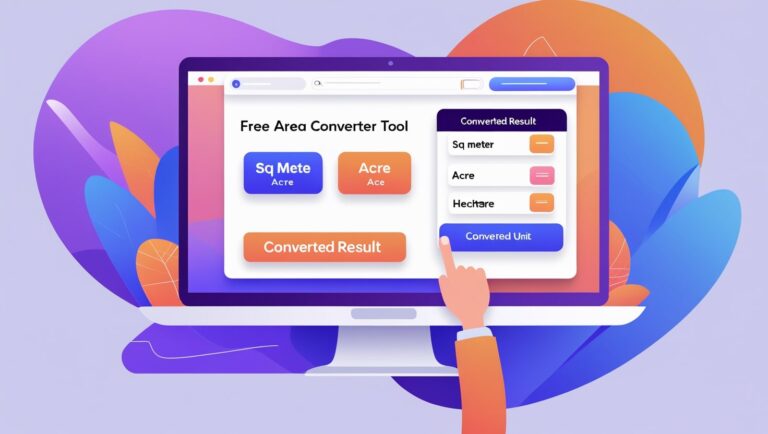
9. SEO Professionals: Why Area Matters
Area Usage in Location-Based Keywords
SEO professionals know that specific metrics like area size can attract localized traffic. Keywords like “2,000 sq ft house in Austin” perform better than generic ones. Use an area tool to optimize listings and blog content with accurate figures.
Property Pages and Real Estate Listings
Including precise conversions helps listings appear in both local and international search results. Convert square feet to square meters to appeal to global audiences.
10. Applications in E-commerce
Selling Land or Real Estate Online
Online land sale platforms must support area conversions to appeal to international buyers. Integrating the MiniToolLab Area Converter Tool improves transparency.
Product Dimensions (e.g., purse, rugs, tiles)
E-commerce product pages for items like rugs, tiles, and bags benefit from accurate area descriptions. This helps customers visualize and compare sizes effectively.
Integration with Product Pages
Embed or link to the converter on pages where area impacts buying decisions. It empowers customers to make informed choices and reduces returns due to miscalculations.
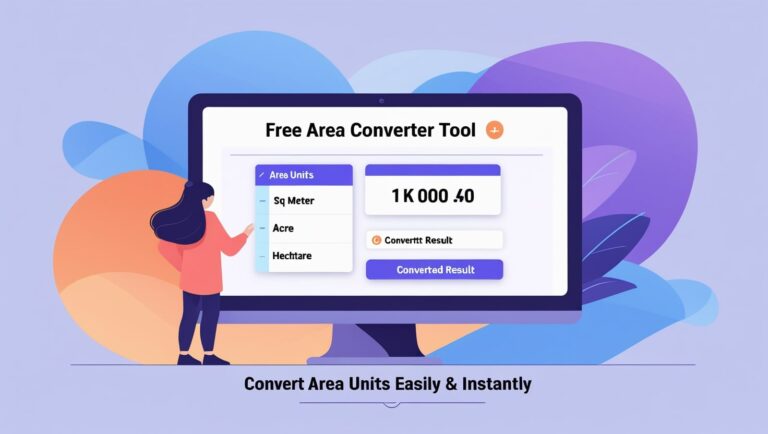
11. Educational Integration
Teaching Units of Area in Schools
Educators can use area converter tools during geometry or geography classes to help students grasp unit conversions in an interactive way.
Integrating Tools in Learning Management Systems
Tools can be embedded in platforms like Moodle or Google Classroom to support remote learning and practical assignments.
Using Area Calculators in Exams and Assignments
Students can use such tools to cross-verify their work. When learning how to convert hectares to acres or m² to ft², visual confirmation builds confidence.
12. Benefits for Architects and Engineers
Design Layouts and Blueprints
Precise area calculation is essential for architectural drawings and blueprints. The tool ensures alignment with project requirements.
Space Optimization
Engineers must optimize space for functionality and cost-efficiency. Using an area tool lets them test configurations quickly.
Comparison Across Measurement Standards
For international collaboration, being able to convert instantly between units like square meters and square feet simplifies communication and project execution.
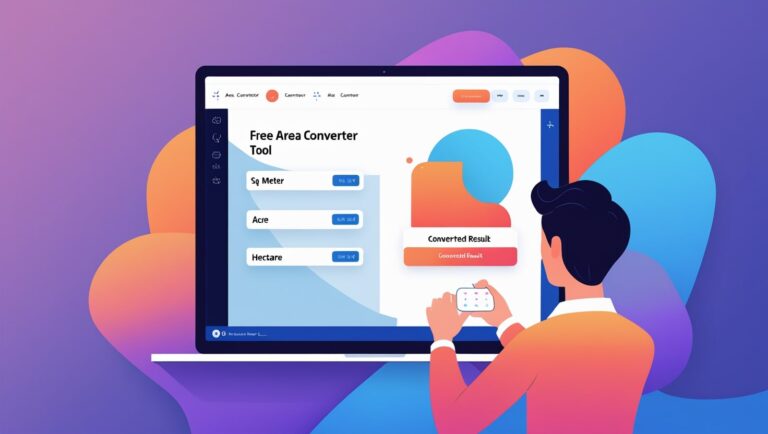
13. Geographic and Regional Relevance
Local Unit Conversions (India, US, UK, etc.)
Different countries use different units to measure land and built-up space:
- India: Bigha, Guntha, Marla, Katha
- US: Square feet, Acres
- UK: Square yards, Hectares
- Japan: Tsubo
This diversity in measurement standards creates a pressing need for tools like the MiniToolLab Area Converter Tool that support both metric and traditional units, empowering users to bridge regional differences in measurement easily.
Land Disputes and Accurate Measurements
Land disputes often arise due to incorrect or misunderstood area measurements. By using a reliable area converter, parties involved can align their understanding and avoid miscommunication, especially in legal or contractual contexts.
Adapting to Legal Requirements
Many regions mandate area representation in local units for property transactions, while developers may require it in metric. Using a dual-unit approach supported by area conversion tools ensures legal compliance and accuracy.
14. Integration into Web Platforms
Embedding Code for Websites
Web developers can easily embed the MiniToolLab Area Converter Tool into property listing sites, educational portals, or construction service platforms. This increases the value of the site and encourages repeat visits.
API Access for Developers
For businesses managing multiple land records, APIs allow integration of conversion functions directly into their software. It automates processes like:
- Area calculation in ERP systems
- Dynamic measurement updates in web apps
- Bulk conversions in databases
Customizing the Tool’s Interface
Developers can often style the embedded version of the tool using CSS to match their site’s look and feel — maintaining brand consistency while delivering utility.
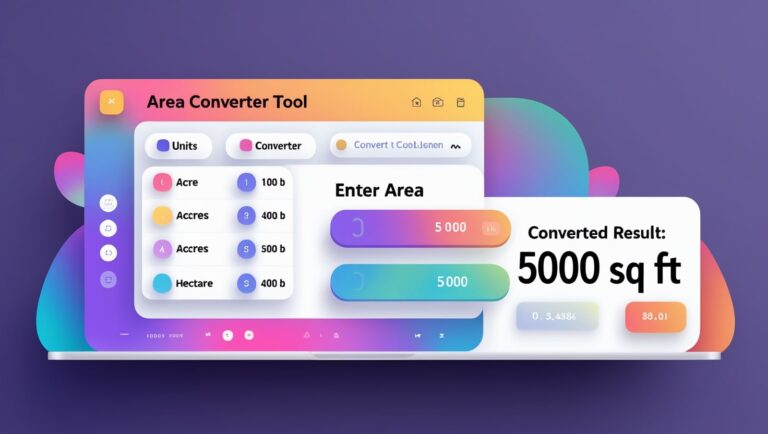
15. Common Mistakes and How to Avoid Them
Selecting the Wrong Unit
Choosing “square inches” instead of “square feet” can drastically skew your data. Always double-check both the source and target units before processing.
Misplacing Decimal Points
Decimal errors are common when converting manually. The online converter handles floating point arithmetic with precision and reduces the risk of such mistakes.
Ignoring Regional Conventions
Some countries use commas instead of periods for decimal points. Be sure your input method matches the tool’s settings.
Overlooking Precision Settings
For technical tasks like architectural design or land valuation, set the precision to at least two decimal places to avoid under- or overestimating values.
16. Advantages Over Manual Conversions
Speed and Convenience
You can convert units in less than 5 seconds. This is far more efficient than manual computation or spreadsheet formulas.
Reduced Error Rates
Since all formulas are pre-programmed and tested, the room for error is practically eliminated, unlike manual conversions that depend on memory or rough estimates.
Accessibility for All Skill Levels
Even users unfamiliar with area units or math can use the MiniToolLab Area Converter Tool without training. The user interface is intuitive and user-friendly.

17. Case Studies
Real Estate Agent Increasing Conversion Rates
A real estate firm added an embedded area converter to their listing pages. Prospective buyers could instantly convert square meters to square feet, boosting buyer confidence. Within three months, lead conversions rose by 22%.
School Using Tool for Better Math Scores
A middle school integrated the tool into its digital learning platform. Students were able to perform area-related assignments faster and more accurately, leading to a 15% improvement in geometry exam scores.
DIY Enthusiasts Planning Home Projects
Home renovators used the converter to calculate how many tiles they’d need for a 450 ft² bathroom. Avoiding over-purchasing saved them over $200 on material costs.
18. User Testimonials and Reviews
Highlight from a Construction Professional
“I use the MiniToolLab Area Converter Tool daily at job sites. It saves time, reduces confusion with subcontractors, and has become an essential part of our workflow.”
Feedback from a Geography Teacher
“My students love using the tool to visualize area conversions. It’s far more effective than blackboard explanations alone.”
E-commerce Seller’s Perspective
“Selling large rugs online, I constantly had to explain area differences to customers. Now I just link to the converter. Returns have dropped significantly.”
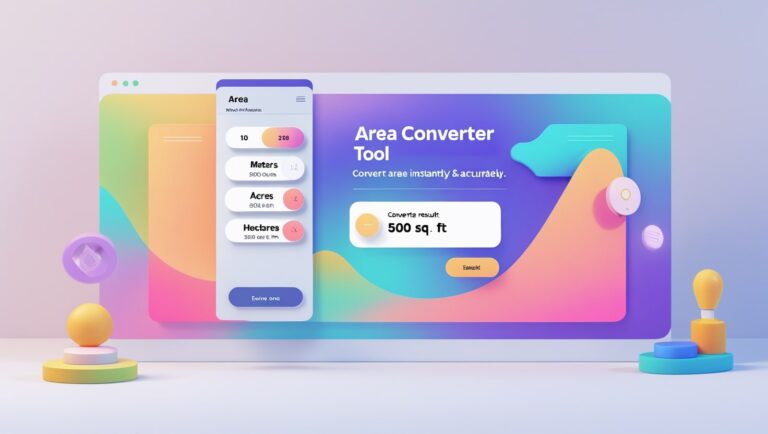
19. Enhancing Productivity with Area Tools
Time Management for Field Workers
Surveyors and construction workers don’t have time for long calculations. A quick-access area tool helps them stay efficient in the field.
Integrated Workflows in Design Software
Some area tools can be used in conjunction with design software through browser extensions or embedded APIs. Architects can calculate while they sketch.
Automated Conversions in Spreadsheets
Use conversion formulas with online tools or exported data to automate large-scale land registry tasks or design calculations.
20. Conclusion
Recap of Benefits
The MiniToolLab Area Converter Tool is more than just a calculator. It’s a universal translator for area units, bridging regions, industries, and user skill levels. From professional applications to everyday use, the tool is fast, accurate, and essential.
Encourage Immediate Use
Don’t waste time juggling manual conversions or uncertain results. Use the tool today and streamline your work, studies, or purchases.
Highlight Importance in Everyday Life
Area conversions aren’t just for experts — they help everyone make smarter, more informed decisions. Whether you’re buying land, remodeling a room, or teaching a class, the right tool makes all the difference.
For More Resources:
FAQ’s:
What is the most commonly used area unit?
Square meter (m²) is the global standard and is most commonly used.
Can I convert acres to square feet?
Absolutely. Just choose “Acre” as the input and “Square Foot” as the output unit
Is this tool mobile-friendly?
Yes! The interface is 100% responsive and optimized for mobile use.
Can I use this tool for construction planning?
Definitely. It’s used in architecture, real estate planning, and engineering fields.
Is it free to use?
Yes, the Area Converter Tool is completely free without any limitations.